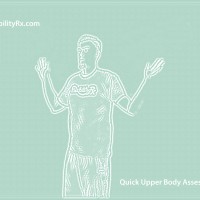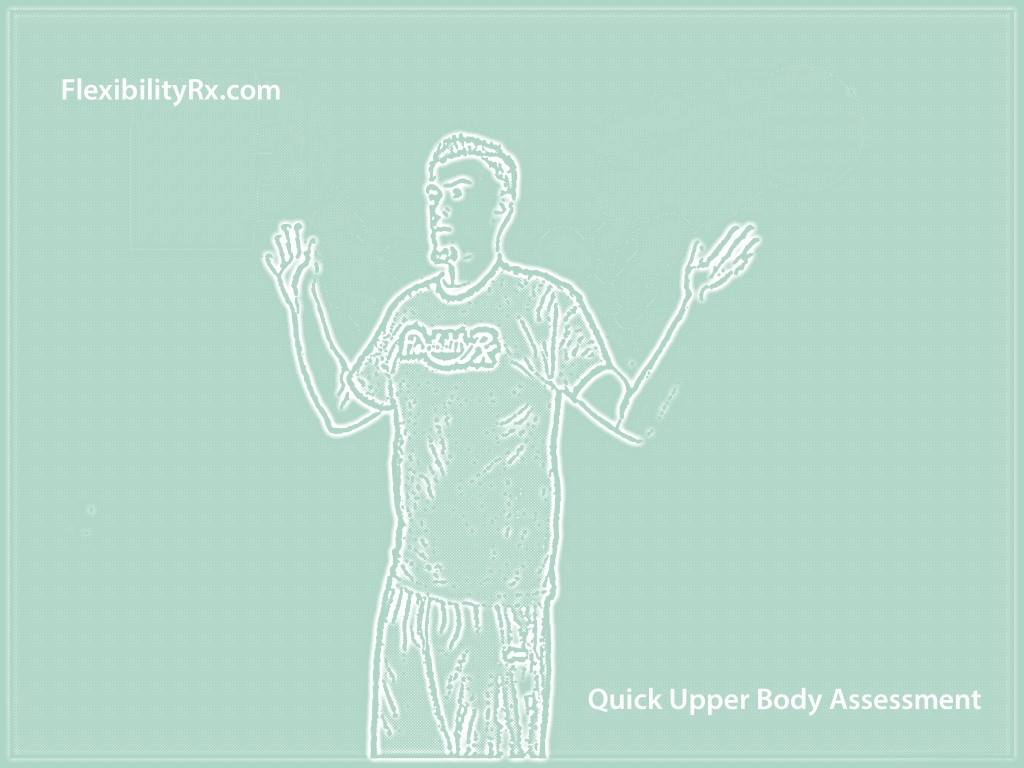
A Quick Upper Body Assessment
The following assessment is a quick screen that I take all athletes through that want to be cleared for overhead lifting. At first glance it may appear that the screen simply measures shoulder external rotation – however the screen reveals much more.
Corrective exercises can be quickly implemented, before being assessed in their effectiveness in improving this position. The best angle for the person performing the screen is from the side where they can see whether or not the low back is in contact with the wall.
Here is what I look for during this screen…
Pelvic Tilt
An athlete that has a strong anterior pelvic tilt (hips tilted forward) will often have a visible downward slant to their pelvis. This often takes the back into excessive hyperextension and will be represented by a visible space between the low back and the wall. Correctives include glute bridges and hip thrusts with an emphasis on a taking the hips into posterior pelvic tilt (tucking the hips under).
Low Back
While pelvic position can affect the low back (lumbar curve) some athletes with a more neutral pelvis will still present an overextended lumbar spine. This is observed by noting space between the low back and wall. This may be caused by a posteriorly tilted ribcage. This athlete can benefit from abdominal exercises that train a ribcage down position (RKC plank, reverse crunch, dying bugs). This flaring of the ribcage can affect shoulder mobility and breathing.
Thoracic Spine
Standing against the wall takes the thoracic spine into extension and is a good way to observe the mobility of the mid-back. Look for stiffness in the chest and an awkwardness of the athlete to maintain their mid back against the wall. Thoracic hypomobility (excessive thoracic kyphosis) will also affect the athlete’s ability to keep their elbows and wrists flat against the wall. Correctives should focus on improving thoracic extension, thoracic rotation (rib roll exercise), and stretching tight pec muscles.
Breathing
If the ribcage is flared upward the athlete will often breathe into their chest and neck and not be able to flatten the low back into the wall. Diaphragmatic breathing is the basis of core stability – glute and abdominal exercises (bird-dog, dying bug) can help restore proper alignment to allow for an athlete to breathe into their sides and belly. The diaphragm is connected to the deep hip-flexor (psoas) and will be dysfunctional if the abdominals are weak and hip-flexors chronically tight. Ask the athlete to take a deep breathe in and note if they are breathing into their neck and chest or allowing the diaphragm to descend and filling the sides of the abdomen and belly. After observing the initial breathe, if they are dysfunctional, ask them to take a breathe into their abdomen and note their ability to correct their breathing with conscious control.
Neck
The low back and thoracic spine influence the curvature of the neck. Note if the athlete is able to keep the back of their head in contact with the wall. A forward head posture can be corrected by practicing hip hinging drills with a pvc or dowel. The good morning (pvc vertical), single leg deadlift, and front plank can all be used to train a neutral neck position.
External Shoulder Rotation
Shoulder rotation is the last component I look at – noting if the elbows and wrist are in contact with the wall. In addition to shoulder stretches, it is essential to mobilize the thoracic spine to allow for the externally rotated arm position that is required for back squats and overhead exercises like pullups. Note that the lats can take the hips into an anterior pelvic tilt and restrict shoulder mobility.
– Kevin Kula, “The Flexibility Coach” – Creator of FlexibilityRx™ – www.FlexibilityRx.com
Tags: overhead lifting, overhead squat assessment, shoulder external rotation, shoulder mobility, upper body assessment

Leave A Reply (No comments so far)
You must be logged in to post a comment.
No comments yet